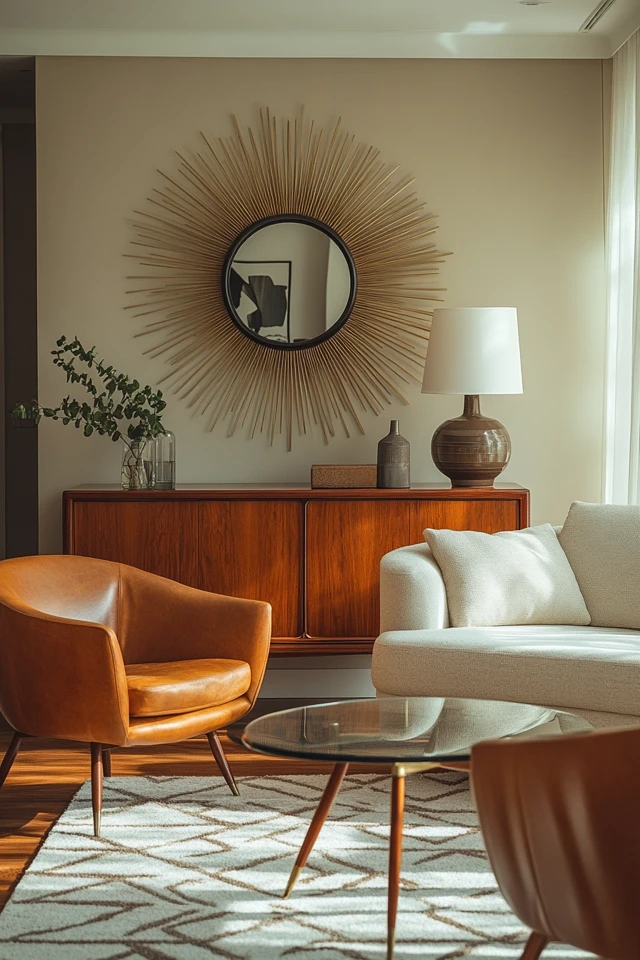The allure of mid-century modern design is undeniable. Its clean lines, organic shapes, and functional aesthetic have captivated designers and homeowners for decades, and for good reason: it strikes the perfect balance between timeless elegance and everyday livability. I discovered this firsthand when I tackled my own living room makeover. I wanted a space that felt sophisticated yet cozy—a room where I could host friends for wine and charcuterie one night and lounge in sweatpants for a Netflix binge the next. Mid-century modern checked every box.
I remember hunting for the perfect pieces at flea markets, estate sales, and even my grandparents’ attic. The excitement of finding a teak coffee table with hairpin legs or a vintage credenza in near-perfect condition was unmatched. But I also learned that it’s not just about owning the right furniture—it’s about how you combine elements like color, texture, and layout to create a cohesive design that feels authentic.
In this post, I’ll guide you through the essentials of creating a timeless mid-century modern living room. Whether you’re starting from scratch or looking to refresh your space, this guide will help you nail that classic, retro vibe with a modern twist.
What Is Mid-Century Modern Design?
Before diving into the specifics, let’s take a quick look at what defines mid-century modern design.
Key Characteristics
- Clean Lines: Furniture and decor with simple, straight, or gently curved lines.
- Functional Aesthetic: A focus on practicality and usability without sacrificing beauty.
- Natural Materials: Wood, leather, and stone dominate, often paired with metal or glass accents.
- Neutral + Bold Colors: Neutral palettes are often accented with pops of vibrant hues like mustard yellow, teal, or burnt orange.
- Connection to Nature: Large windows, indoor plants, and organic shapes bring the outdoors in.
1. Start with Iconic Furniture
The backbone of any mid-century modern living room is its furniture. The pieces you choose will set the tone for the entire space.
Sofas and Armchairs
Look for low-profile sofas with clean, boxy shapes and tapered wooden legs. Upholstery in neutral colors or textured fabrics like tweed or leather works well. Accent chairs with sculptural frames, like the Eames Lounge Chair or a molded plastic chair, add personality.
Example:
Pair a gray tufted sofa with a mustard-yellow armchair for a retro vibe that doesn’t feel dated.
Coffee Tables and Side Tables
Mid-century modern tables often feature geometric shapes and organic materials. Teak, walnut, or rosewood tables with thin, tapered legs or hairpin bases are a must.
Example:
A round walnut coffee table with a smooth finish is both practical and stylish.
Storage Pieces
Credenzas, sideboards, and bookshelves with sliding doors or open shelving are staples. These pieces often feature rich wood tones and minimalist hardware.
2. Master the Color Palette
Mid-century modern design embraces a balance of neutrals and bold colors.
Neutral Base
Start with a neutral base for larger pieces like sofas or walls. Think shades of white, beige, gray, or muted greens.
Accent Colors
Add personality through accents in rich, saturated hues like burnt orange, mustard yellow, olive green, or teal. These colors were wildly popular in the 1950s and ’60s and still feel fresh today.
Pro Tip:
Use the 60-30-10 rule. Make 60% of your room a neutral color, 30% a complementary shade, and 10% a bold accent.
3. Incorporate Natural Materials
Mid-century modern interiors have a strong connection to nature. Incorporate materials like wood, leather, and stone to ground your space.
Wood
Teak and walnut are iconic choices for furniture. Use them for tables, shelving, or even accent walls.
Leather
Opt for leather upholstery on chairs or ottomans for a sophisticated yet approachable look. A caramel leather accent chair can work wonders in pulling the room together.
Stone
A slate or travertine coffee table adds an organic element that complements the warmth of wood and leather.
4. Layer Textures and Patterns
Mid-century modern design might be clean and streamlined, but layering textures and patterns is essential to keep the space from feeling flat.
Textiles
- Use throw pillows and rugs to introduce softness.
- Opt for geometric or abstract patterns that echo the era’s love of shapes.
- Wool, linen, and velvet are excellent fabric choices.
Example:
A geometric wool rug in muted colors paired with velvet pillows creates an inviting look.
Accessories
Incorporate ceramics, glass, or woven baskets for visual interest.
5. Add Mid-Century Lighting
Lighting is one of the easiest ways to bring mid-century modern design into your living room.
Iconic Styles
- Sputnik Chandeliers: These starburst-style fixtures are a hallmark of the era.
- Arc Floor Lamps: Perfect for positioning over a sofa or reading nook.
- Tripod Lamps: Add sculptural appeal to corners or side tables.
Materials to Look For
Brass, matte black, and frosted glass are commonly used in mid-century lighting fixtures.
Picture Gallery
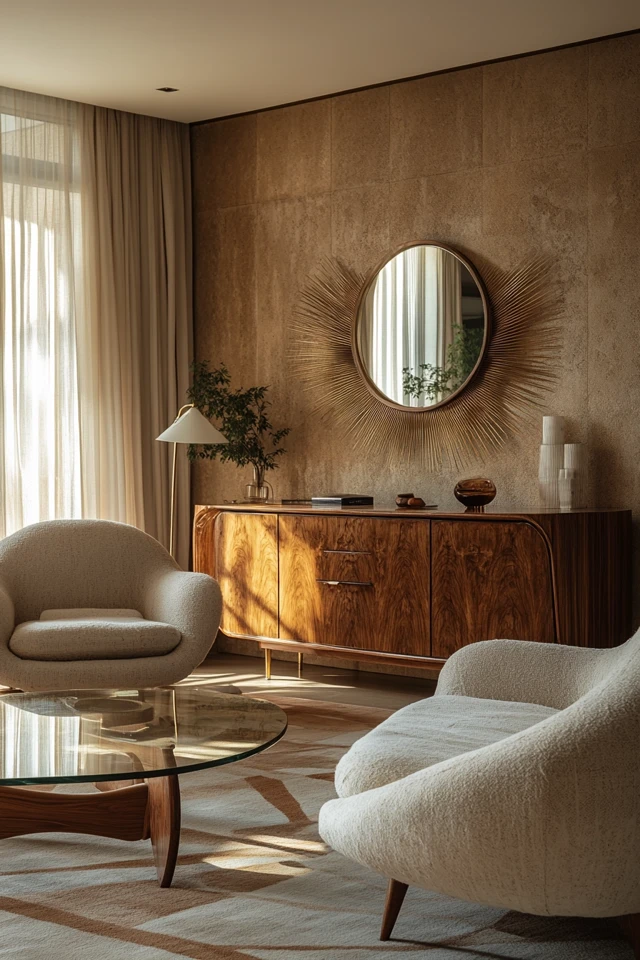
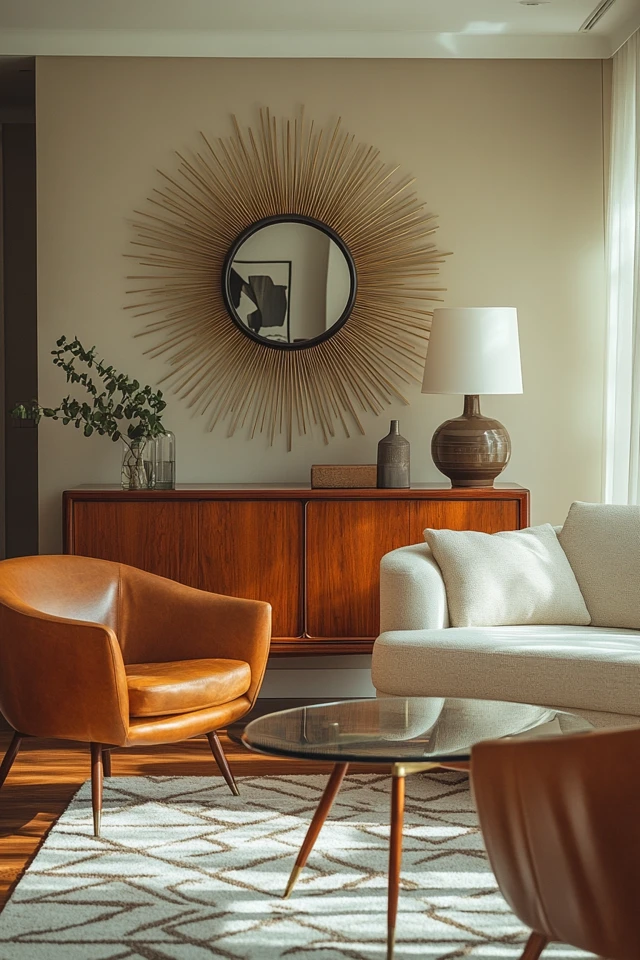
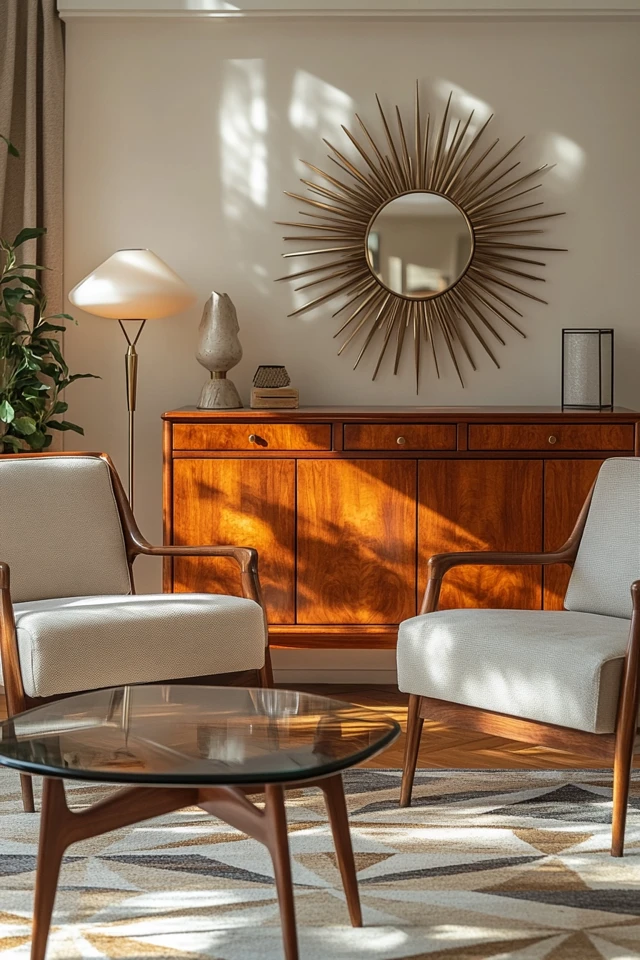
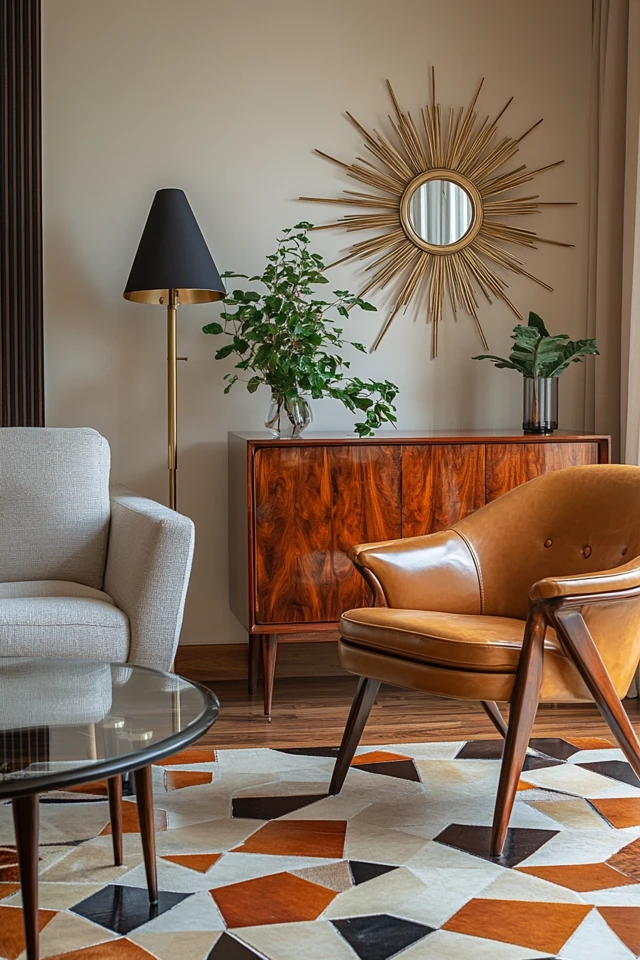
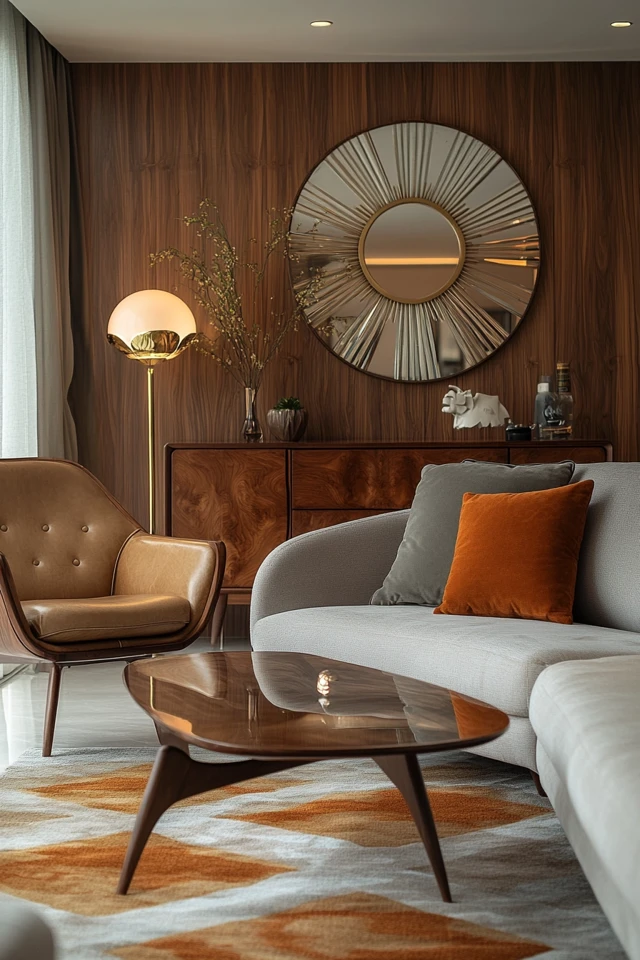

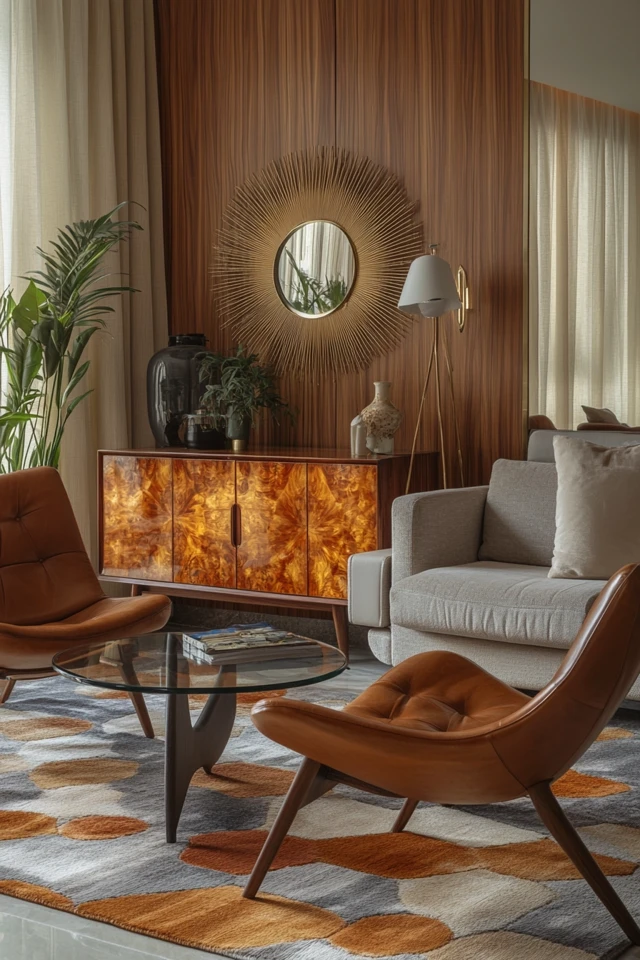
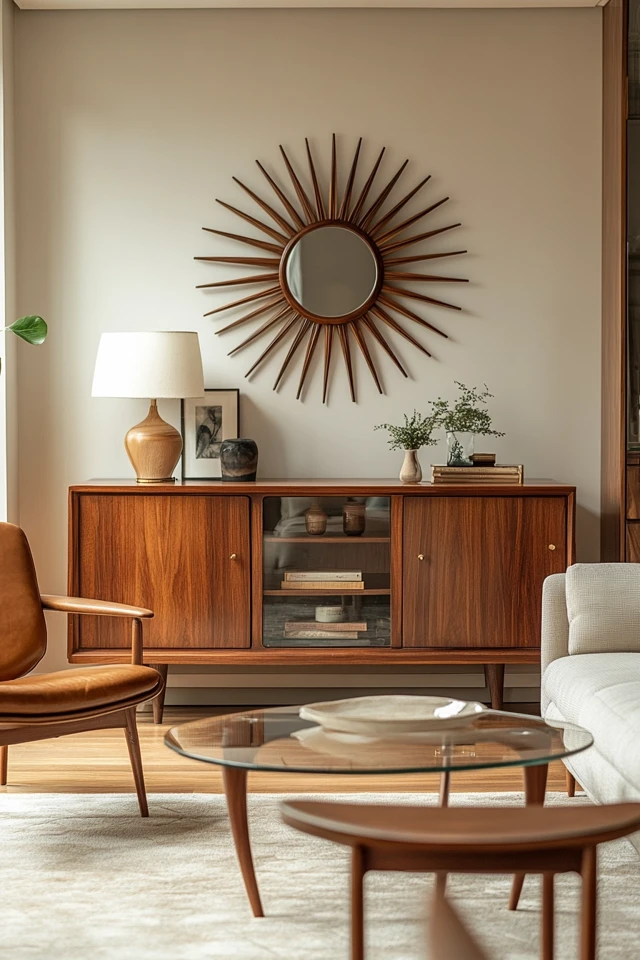
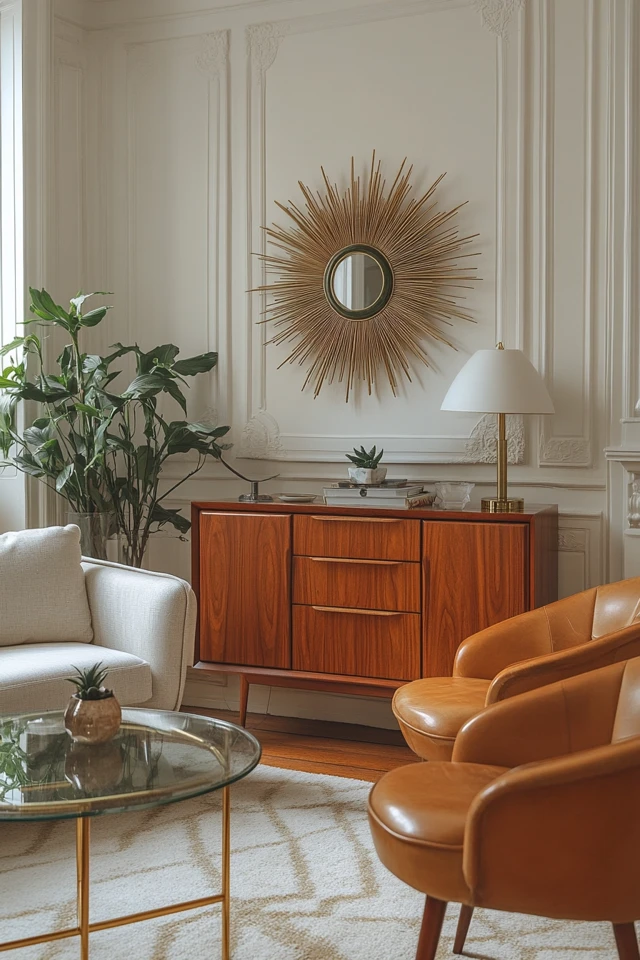
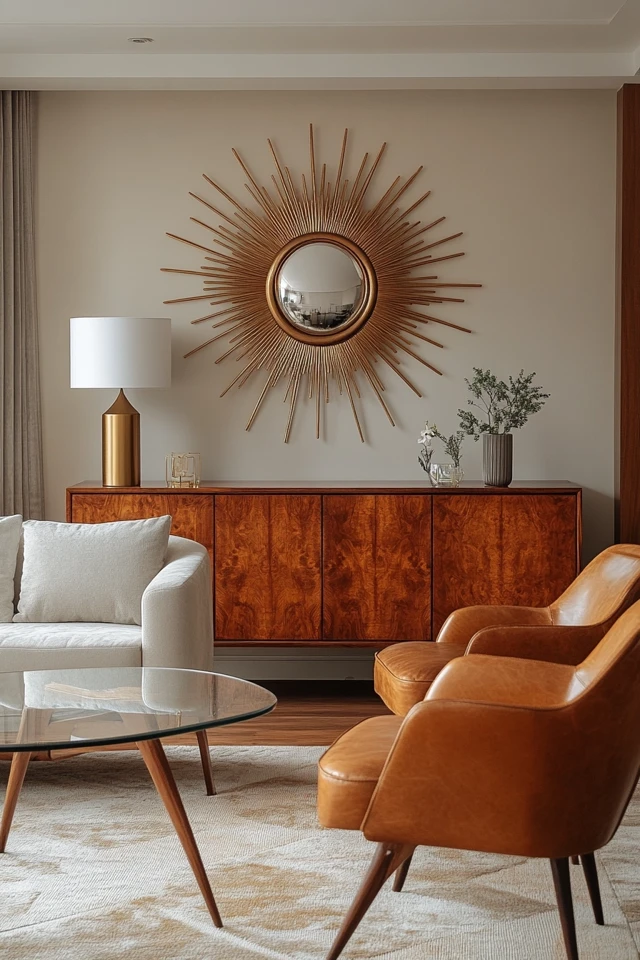
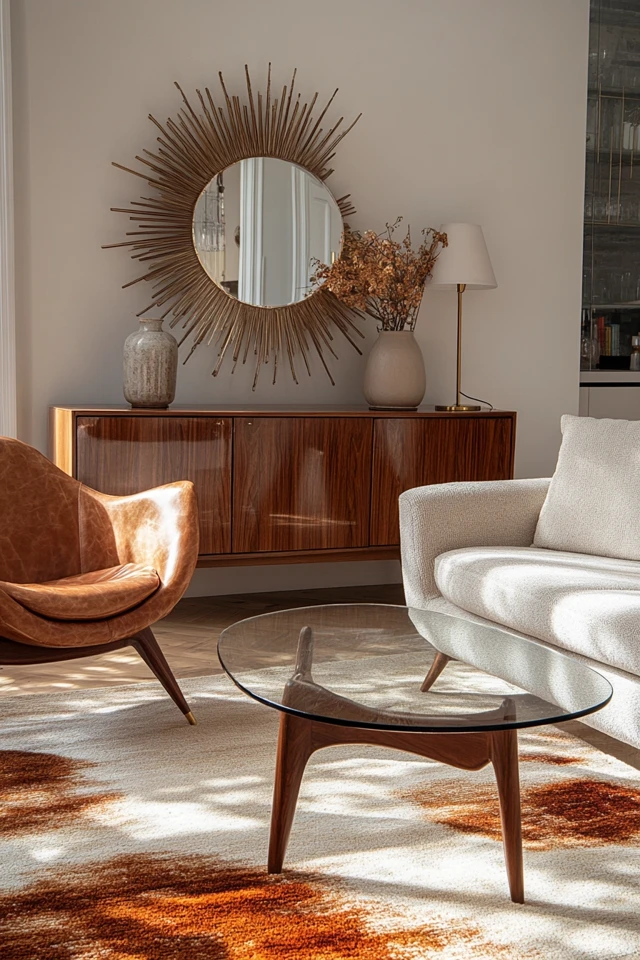
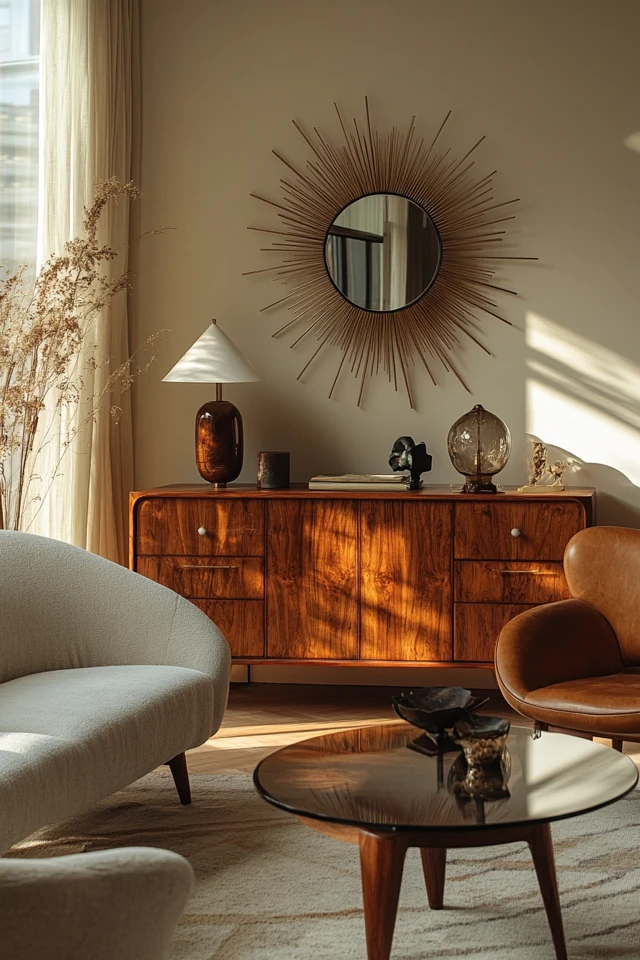
6. Embrace Open Layouts
Mid-century modern homes were designed with open, airy layouts in mind. Even if your living room isn’t large, you can recreate this effect.
Furniture Placement
- Avoid crowding the space; keep pathways clear.
- Use rugs to define seating areas within larger rooms.
Windows
Let natural light take center stage. Keep window treatments minimal with sheer curtains or sleek blinds.
7. Add Retro-Inspired Art
Mid-century modern design often includes bold, abstract artwork. Choose pieces with geometric shapes, vibrant colors, or minimalist designs.
Ideas:
- A large-scale print featuring abstract shapes in teal and orange.
- A gallery wall with black-and-white photography in simple wooden frames.
8. Incorporate Plants
Greenery adds life and reinforces the connection to nature.
Plants to Consider
- Fiddle Leaf Fig: Iconic and sculptural.
- Snake Plant: Low-maintenance and stylish.
- Rubber Plant: Lush and vibrant.
Planters
Use ceramic or wooden planters with clean, simple lines to stay on theme.
9. Highlight Architectural Details
If your home has architectural features like exposed beams or brick, play them up—they align perfectly with the mid-century aesthetic.
Enhancements
- Paint wood trim in warm, natural tones.
- Use floating shelves to showcase the linear quality of walls.
10. Personalize with Vintage Finds
One of the joys of mid-century modern design is how well vintage pieces fit into the aesthetic.
What to Look For
- Vintage clocks or bar carts.
- Sculptural ceramics from the era.
- Classic books or records for display.
Pro Tip:
Mix vintage pieces with modern accents to avoid a “time capsule” effect.
Conclusion
Creating a timeless mid-century modern living room is all about balance. By combining iconic furniture, natural materials, and carefully chosen accents, you can design a space that feels both retro and contemporary. Personally, I’ve found that the beauty of this style lies in its adaptability—it can be as sleek or as cozy as you want it to be.
When I sit on my tufted sofa, surrounded by wood accents and bathed in the warm glow of my Sputnik chandelier, I’m reminded of how intentional design can create a home that feels both functional and beautiful. That’s the magic of mid-century modern.
So, whether you’re adding a few touches or diving into a full makeover, remember: mid-century modern isn’t just a design trend—it’s a lifestyle that celebrates simplicity, functionality, and timeless charm. Happy decorating!
FAQ
What is the key to achieving a timeless mid-century modern look?
Focus on clean lines, natural materials, and a balance of neutral and bold colors. Incorporate iconic furniture and lighting to anchor the design.
Can I mix mid-century modern with other styles?
Absolutely! Mid-century modern pairs well with Scandinavian, bohemian, and even industrial styles. Just be sure to maintain balance and cohesion.
Where can I find authentic mid-century modern furniture?
Check out estate sales, vintage stores, and online marketplaces like 1stDibs, Chairish, or Facebook Marketplace. Reproductions are also widely available.
What are the best colors for a mid-century modern living room?
Neutrals like white, gray, and beige work well as a base. Add pops of mustard yellow, teal, olive green, or burnt orange for accents.
Is mid-century modern still trendy?
Yes! Mid-century modern’s timeless appeal and adaptability ensure that it remains a popular choice in interior design.

